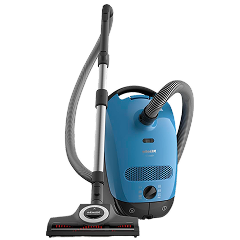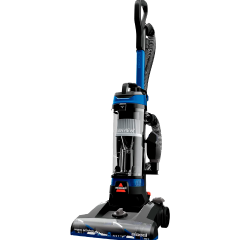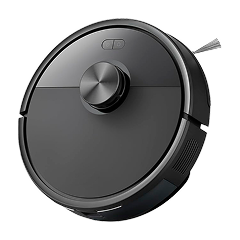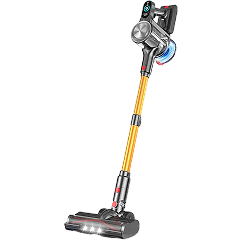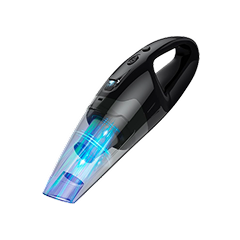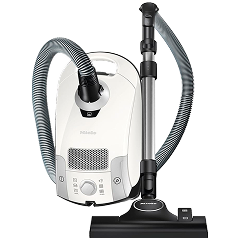Los robots aspiradores han avanzado mucho en los últimos años, antes eran una novedad tecnológica más, pero han avanzado hasta el punto de que algunos modelos son una excelente alternativa a la limpieza manual.
También se han diversificado en cuanto a precio y funciones para que puedas elegir el que mejor se adapte a tus necesidades. El problema es que en Internet hay muchísimos productos comercializados por marcas de las que quizás nunca habías oído hablar.
Como he estado probando e investigando sobre robots aspiradores desde 2013, en este artículo te voy a hablar sobre las características que debería tener un buen robot aspirador. A la hora de elegir el modelo adecuado deberías comprobar primero que es el indicado para el tipo de suciedad que quieres limpiar, que puede moverse por tu casa con facilidad y que tiene las características adicionales que mejor te convengan.
Cómo elegir el robot aspirador adecuado
Tipo
Para simplificar el tema, voy a dividir los robots aspiradores en dos categorías: los de solo aspiración y los híbridos de aspirador y friegasuelos.
Los modelos que solo aspiran suelen ser más económicos y limpian mejor el pelo y la suciedad (salvo que pagues por uno de gama alta). Los robots híbridos de aspirador y friegasuelos pueden tener características distintas, desde un simple paño de microfibra hasta almohadillas giratorias de fregado.
Todo dependerá del tipo de suelo que tengas en tu casa. Obviamente, si tienes alfombras fijas en toda la superficie, deberías optar por un modelo que solo aspire. En cambio, tal vez deberías evitar los modelos híbridos si tienes una moqueta gruesa o alfombrillas en el baño.
Esto se debe a que muchos modelos híbridos de gama básica arrastran la mopa húmeda al pasar de suelo duro a moqueta o alfombra. No obstante, las marcas de gama alta tienen modelos que levantan las almohadillas de la mopa cuando detectan alfombras, pero tendrás que pagar un precio superior por un robot aspirador que tenga esta función.
Características de la base de carga
Lo siguiente en lo que debes fijarte es en las características de la base. Para la gran mayoría de los robots aspiradores, la base es solo un lugar en el que el dispositivo se carga y sirve como punto de partida para la navegación. En los modelos más costosos, la base es uno de los principales atractivos.
En mi opinión, una base con función de vaciado automático es la que ofrece la mejor relación calidad-precio. Estas bases tienen un aspirador secundario que aspira los contenedores de suciedad del robot y coloca el contenido en un contenedor independiente dentro de la base o, mejor aún, en una bolsa que se cierra herméticamente. Si adquieres un modelo que pone el contenido en una bolsa, no tendrás que oler, tocar ni ver nada desagradable al tirar la suciedad. También es más higiénico, ya que la bolsa evita las acumulaciones de polvo que vuelven a introducir alérgenos en tu hogar.
Un nivel por encima de los modelos con función de vaciado automático sería una base capaz de limpiar las mopas y rellenar los tanques de agua. El interior de la base tendrá un depósito de agua limpia y otro de agua sucia que habrá que rellenar y vaciar, respectivamente. Algunas de las bases de estos modelos híbridos también cuentan con función de vaciado automático.
Las mejores bases que he probado tenían todas las características anteriores, así como almacenamiento. De manera que podían guardar bolsas adicionales, filtros e incluso servían para cargar un aspirador inalámbrico que tuvieran incluido. Al final, lo que adquieres es un centro de limpieza, un lugar donde podrás encontrar todo lo que necesitas para aspirar el suelo.
El inconveniente es que, a medida que aumenta el número de funciones de una base, también aumenta su tamaño. Una base muy simplista cabe en la palma de la mano, mientras que un centro de limpieza puede ocupar fácilmente un espacio de 250 centímetros cuadrados o varios metros cuadrados. También pueden ser bastante altas, más o menos hasta la rodilla de una persona de estatura media. Así que, si estás pensando en comprar una base que sirva para todo, primero tienes que pensar bien dónde la vas a instalar.
Navegación
Muchos robots aspiradores emplean múltiples tecnologías para orientarse en tu casa y para sortear obstáculos. Pueden emplear LiDAR, vSLAM y visual.
Además de utilizar sensores para moverse por las habitaciones, los robots aspiradores también utilizan sensores sónicos e infrarrojos para identificar qué tipo de superficies están limpiando. Esto ayuda a que los modelos híbridos puedan alternar entre fregar y aspirar y ajusta la succión en los modelos aspiradores. Estos sensores también se usan para que el robot no se caiga de una zona alta.
Para saber cuál es la mejor opción deberías tener en cuenta varios puntos. Si tienes mascotas y niños, invertir en un robot aspirador que utilice un sistema de navegación visual es una buena inversión, ya que pueden evitar accidentes con tus mascotas, cosas que estén tiradas en el suelo y cables eléctricos. Básicamente, se adaptan si hay desorden.
En el lado opuesto, si solo quieres comprobar si un robot aspirador es la opción adecuada para tu estilo de vida, un modelo vSLAM más económico es la mejor opción, ya que son asequibles y fiables cuando simplemente quieres probar si un robot aspirador es lo que necesitas para tu casa.
Funciones inteligentes
Lo que más cambia al usar un robot aspirador frente a uno tradicional son sus funciones inteligentes.
La aplicación más básica te permitirá iniciar, detener y programar tu robot a través de tu smartphone. Puede que no parezca gran cosa, pero imagina que estás en el trabajo y te enteras a última hora de que tienes invitados en casa. Si tu robot aspirador tiene conectividad, puedes activarlo desde cualquier lugar donde tengas señal y hacer que limpie tu casa antes de que llegues.
Más allá de simplemente encender el robot aspirador, las funciones inteligentes han evolucionado hasta cubrir una gran variedad de usos. Por ejemplo, hay robots aspiradores con cámaras que pueden enviar lo que “ven” a tu teléfono. Si a eso le añadimos la función de control remoto, también tendríamos una cámara de seguridad móvil. Algunos incluso tienen altavoces y micrófonos para que puedas decirle a tu perro que se levante del sofá.
Todas estas razones hacen que sea importante comprobar cuáles son las características inteligentes con las que viene un robot aspirador o si no tiene ninguna.
Capacidad de aspiración
La succión de un robot aspirador suele representarse en pascales, denominados «Pa». Cuando veas que un robot aspirador tiene 5.000 Pa de succión, eso equivale aproximadamente al 0,5 % de la presión que la atmósfera ejerce sobre ti en este momento. Dentro del mundo de los robots aspiradores es un valor elevado, aunque modesto en comparación con la presión total.
La manera en que se mueve en los espacios importa más que la succión, ya que un robot aspirador no limpia las zonas por las que sus cepillos no llegan a pasar.
Marcas de robots aspiradores y sus prestaciones
iRobot
Hablar de robots aspiradores es hablar de iRobot. En mi experiencia, tanto si compras sus modelos asequibles como los de gama alta, el producto siempre será de calidad.
Incluso los modelos básicos tienen funciones de primer nivel, como una base que vacía automáticamente el cubo del robot y un mapeo inteligente, que te permite indicarle al robot en qué zonas quieres que se centre o cuáles te gustaría que evitara.
Con los modelos de gama alta obtendrás un robot que puede fregar y con navegación visual. Esta última función es la vanguardia de los robots aspiradores porque le permite reconocer y evitar obstáculos comunes como cables de alimentación y otros objetos.
Quizás te sorprenda, pero según mi experiencia con iRobots cuando lo que quieres es un robot que limpie bien alrededor de los muebles, los modelos más asequibles son los mejores. Esto se debe a que cuanto mejor sea la navegación, más probable será que el robot evite los espacios estrechos para evitar quedarse atascado. Tenlo muy en cuenta a la hora de comprar un robot.
Algo que me parece destacable de iRobot es que ha resistido el paso del tiempo y que siempre ha ofrecido un buen servicio al cliente.
Eufy
Eufy es una empresa derivada del fabricante de electrónica Anker que se especializa en la fabricación de artículos asequibles para el hogar. Los modelos básicos de Eufy tienen una buena succión y son de baja altura para que puedan pasar fácilmente por debajo de los muebles.
A lo largo de los años, Eufy ha seguido de cerca lo que han hecho sus competidores y cuando una función es buena, el siguiente modelo de Eufy suele darle su propio toque. Por ejemplo, cuando iRobot y Ecovacs empezaron a utilizar la navegación visual, Eufy acabó sacando su propia versión con una tecnología similar.
Otro aspecto que me gusta de Eufy es que se vende casi exclusivamente en Amazon, por lo que suele tener descuentos.
Ecovacs
Ecovacs fabrica robots aspiradores inteligentes que se encuentran entre los mejores del mercado. La empresa fabrica modelos que pueden mostrarte lo que ven en tu teléfono móvil y algunos tienen bases que lavan las almohadillas de las mopas. Si estás buscando la navaja suiza del mundo de los robots aspiradores, deberías echarle un vistazo a Ecovacs.
El mayor inconveniente es que incluir las mejores funciones en un robot aspirador incrementa su precio.
Me parece admirable que la marca Ecovacs nunca se haya quedado estancada, ya que siempre están probando algo nuevo. No obstante, eso significa que a veces los modelos se descatalogan pronto para dar paso a los modelos estrella.
Errores comunes al comprar un robot aspirador
Esperar milagros en la limpieza
Algunas personas compran un robot aspirador esperando que sustituya al 100 % a su aspiradora manual. Si bien esto es posible, también requiere un esfuerzo por tu parte, como poner el robot todos los días y procurar que el suelo esté lo más despejado posible.
Los robots aspiradores de hoy en día todavía no pueden competir con la limpieza a fondo hecha a mano y siempre existe la posibilidad de que compres un modelo muy costoso y descubras que tu mascota lo odia.
Creo que lo mejor es comprar un modelo económico y probarlo para ver si se adapta a tu estilo de vida. Siempre es mejor asegurarse antes de comprar un modelo costoso, en caso de que tu gato o perro odien el ruido o el movimiento de estos aparatos.
No realizarle un mantenimiento regular
Aunque el robot aspirador tiene funciones automáticas, necesita que le echen una mano de vez en cuando, desde vaciar el cubo del polvo hasta limpiarle los sensores. Un mantenimiento adecuado aumentará en gran medida su vida útil.
No usar todas sus funciones
Muchos robots aspiradores vienen con funciones adicionales, como una cámara o un sistema de auto-vaciado. Si has pagado por todo esto, deberías utilizarlos para sacarle el máximo partido a tu robot.


